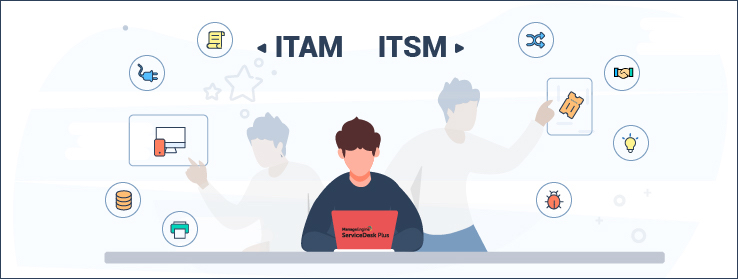[Blog] Benefits of managing ITAM and ITSM together

ITAM:
The acronym of ITAM is "Information Technology Asset Management". In simple words, ITAM comprises of IT asset tracking and IT asset management. ITAM is a set of best practices that allows your IT team to manage, control, and protect all IT assets across the organization. The IT asset management process typically involves gathering a detailed inventory of an organization's hardware, software, and network assets and then using that information in business decisions about IT-related purchases and redistribution.
ITSM:
The acronym of ITSM is "Information Technology Service Management" it refers to all managerial aspects of IT businesses. It mainly focuses on Process, Support, Delivery, Security and Infrastructure, and other provisions for better customer service. ITSM ensures the timely delivery of essential services and support for the Enterprise. Customer satisfaction and business goals are at the core of ITSM success.
The togetherness of ITSM and ITAM:
IT service management (ITSM) and IT asset management (ITAM) are often thought of as two separate disciplines, however, they are very closely related siblings when it comes to IT management, yet they often don’t play together as much as they could. While they might often reside within two different IT systems. In the IT environment employees, refer's "Assets" as Hardware and Software. But ITAM goes beyond the assets to also include "the set of business practices that join contracts, inventory functions to support asset lifecycle management. ITAM can be integrated with many ITIL processes that are included in ITSM including Incident management, Service management, Change management, Purchase management, and much more. ITSM ensures the timely delivery of essential services and support for the Enterprise. When ITSM and ITAM can be integrated, they offer several benefits that can help IT organizations reduce costs, improve efficiencies, and reduce downtime.
Incident Management with ITAM:
In an IT environment incident submitted by users can be related to several things across the Enterprise. When incidents submitted related to assets may need more attention, it can be even a critical component of the Enterprise. IT ServiceDesk integrated with ITAM helps the incident team with relevant information such as asset owner, previous asset history, configuration details, associated assets, number of incidents created for particular asset along with the current ticket status. The information fetched from ITAM leads to resolve incidents more quickly and avoid future problems. In turn, makes the user happier.
Service Request Management with ITAM:
Service Catalog is a structured document with information about all IT services offered by the IT team to users. ITAM assists the service request team whenever a user places requests for a particular service. Let say he/she requests for a new Laptop, ITAM checks the availability of a particular asset with the procurement team. In the case of asset unavailability, ITAM manages to raise a PO, orders the asset, and perform the necessary process (approval, invoice, documentation, etc) to complete the PO cycle. ITAM delivers the asset to the user through the SR management team. IT Asset Management and SR management team collaborate to meet the SLA committed to the user and remain compliant with the ITAM policy.
Problem Management with ITAM:
Problem Management is an IT Service Management process to prevent problems and incidents from occurring and resolve known problems with a permanent solution. Both processes of Problem and Incident Management are interrelated, the reason being incident records are essential for successful problem identification, while Problem Management aims at providing permanent solutions to root cause issues, Incident Management focuses more on quick solutions. Correlating asset information with help of ITAM, IT Incident and Problem management provides IT-team, with valuable insight into asset health and life cycles. IT teams can determine why certain devices regularly fail, which may lead them to decide whether it’s financially viable to continue fixing these devices or may decide to standardize on a different model as a replacement going forward. Proactively maintaining devices and taking decisions helps cutting down unwanted risk and downtime, paves way for efficient business productivity.
Change Management with ITAM:
IT change management plays a crucial role in business functions. Integrating ITAM within change management during the risk analysis process mitigates the risks involved and the change process is defined properly based on this. ITAM provides information to a change team regarding asset location, impact, and configuration details. ITAM team members working closely with the change management team can assist in issues before ahead of change is implemented, which avoids unwanted hassles and saves time.
Final thoughts:
Unified ITSM and ITAM processes, can help your organization in several ways. ITSM supplies a lot of data around asset failure and performance that is quite valuable for asset managers. Understanding which asset models perform best, or worst, can help IT determine the best asset standards that will help increase the reliability of services over time. ITAM collects inventory details that are very useful to the service desk. This includes information about an end user's machine, where they are located, and what software the end-user is entitled to have. These examples are just a glimpse of what is possible with ITAM and ITSM together.
Thank you for your time, I hope you find this article useful!
Please follow this article to know more about - ITAM best practices
Check our previous blog on - Understanding the differences between Help Desk and Service Desk